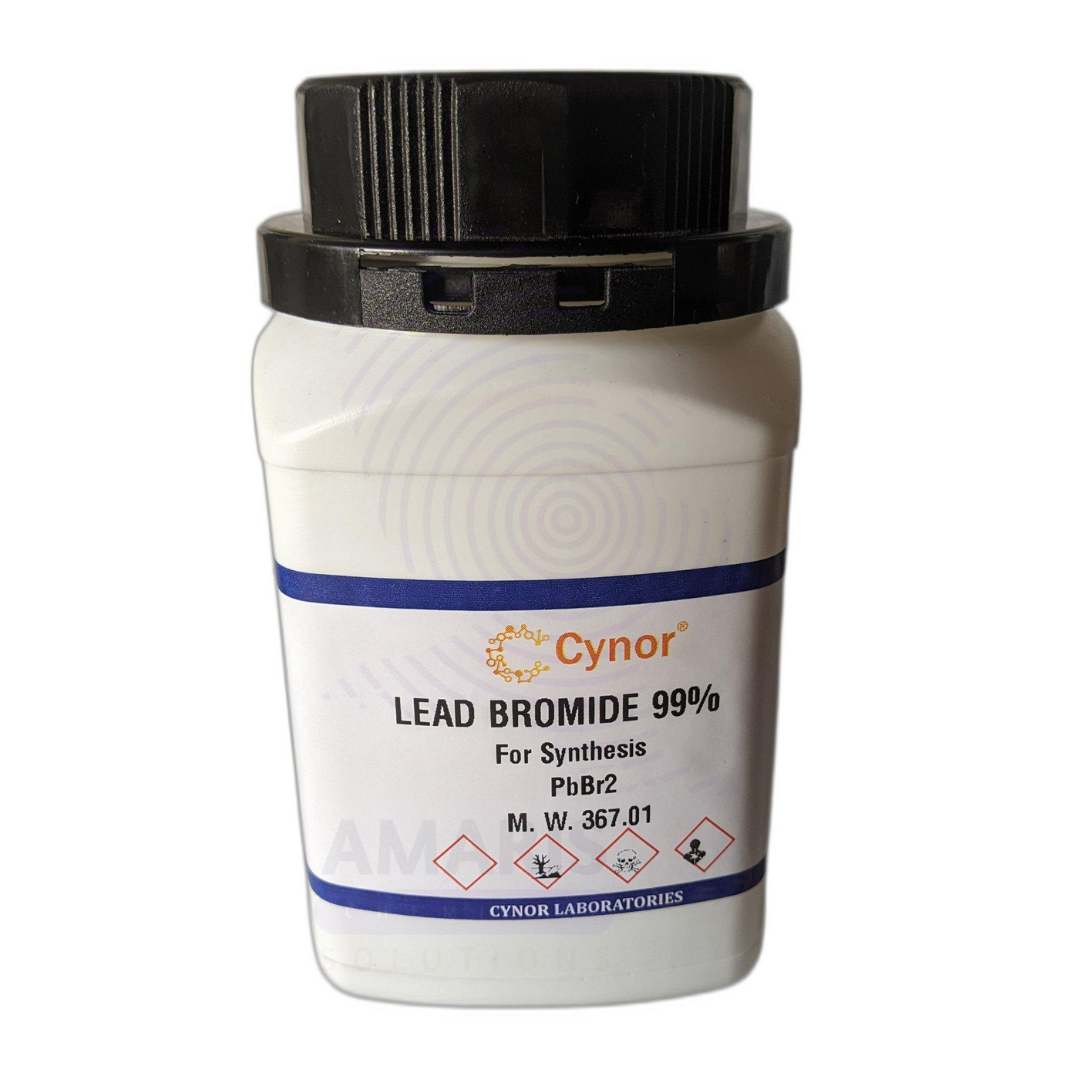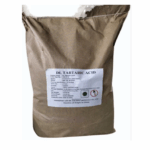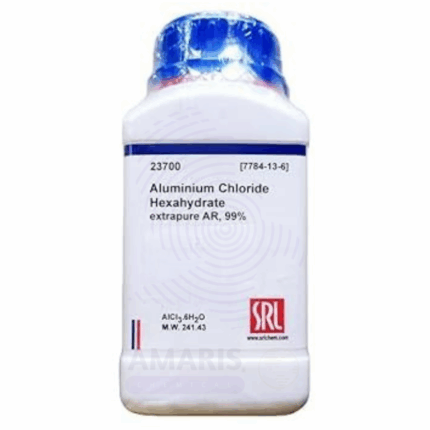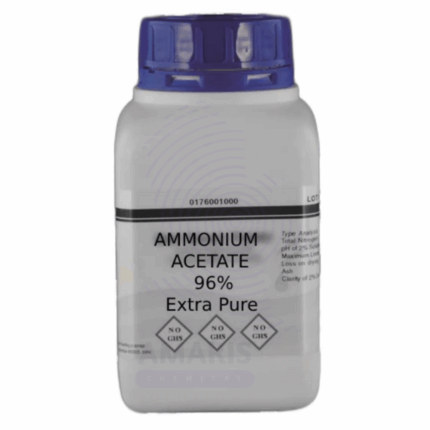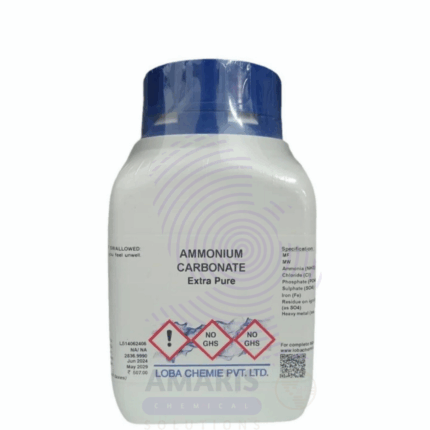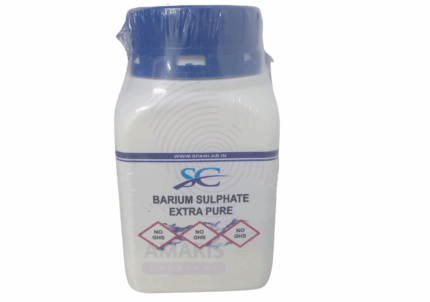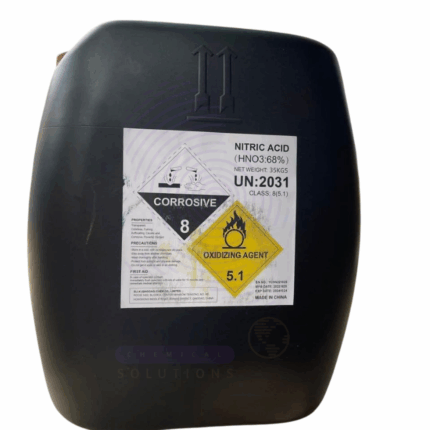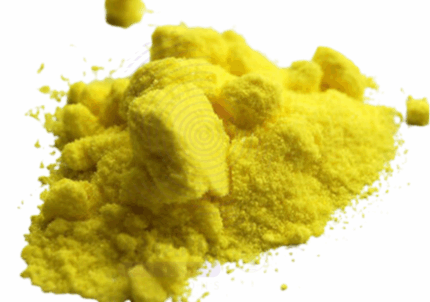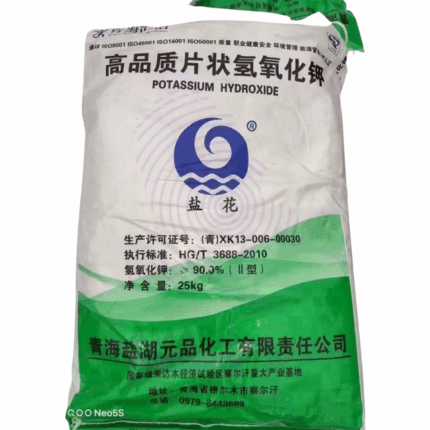
Lead Bromide Extra Pure
$ 18.85 Original price was: $ 18.85.$ 18.76Current price is: $ 18.76.
Lead Bromide Extra Pure is a high-purity inorganic compound with the formula PbBr₂, appearing as a white to pale yellow crystalline solid. It is commonly used in laboratory settings for materials research, particularly in the development of photovoltaic cells, optoelectronic devices, and perovskite-based semiconductors. In analytical chemistry, it can serve as a reagent or intermediate in complex synthesis. Due to its low solubility in water and its thermal properties, it is also explored in crystal growth studies. As with all lead compounds, strict safety precautions must be observed during handling due to its toxic nature.
Lead Bromide Extra Pure
Primary Uses
- Synthesis of Perovskite Materials:
Frequently used in the preparation of lead halide perovskites (e.g., MAPbBr₃), which are key in solar cell, LED, and photodetector research. - Crystallography and Materials Science:
Employed in crystal growth studies to examine structural and optical properties of bromide-based compounds.
Secondary Uses
- Precursor in Inorganic Synthesis:
Utilized as a source of Pb²⁺ and Br⁻ ions in the preparation of complex lead bromide salts and hybrid materials. - Photoconductivity Studies:
Explored in semiconductor and photoconductivity research due to its electrical behavior under light exposure. - Thermal Decomposition Studies:
Used in thermal stability and decomposition experiments to investigate bromide volatilization and lead oxide formation.
| PACK SIZE |
500 grams Plastic Tin |
|---|
1. Basic Identification Attributes
- Chemical Name: Lead(II) Bromide
- Synonyms: Plumbous bromide
- Chemical Formula: PbBr₂
- CAS Number: 10031-22-8
- Molecular Weight: 367.01 g/mol
- Grade: Extra Pure (suitable for laboratory and analytical use)
- Appearance: White to off-white crystalline powder
- Odor: Odorless
- Solubility: Slightly soluble in water; more soluble in hot water
- Melting Point: ~373 °C
- Boiling Point: Decomposes above 900 °C
2. Safety & Hazard Attributes
- GHS Classification:
- Acute Toxicity (Oral) – Category 4
- Reproductive Toxicity – Category 1A
- Specific Target Organ Toxicity (Repeated Exposure) – Category 2
- Aquatic Chronic – Category 2
- Hazard Statements:
- H302: Harmful if swallowed
- H360: May damage fertility or the unborn child
- H373: May cause damage to organs through prolonged or repeated exposure
- H411: Toxic to aquatic life with long lasting effects
- Precautionary Statements:
- P201: Obtain special instructions before use
- P260: Do not breathe dust or fumes
- P264: Wash hands thoroughly after handling
- P280: Wear protective gloves, clothing, and eye protection
- P273: Avoid release to the environment
- Personal Protective Equipment (PPE):
- Lab coat
- Nitrile gloves
- Chemical splash goggles
- Dust mask or respirator if ventilation is inadequate
- First Aid Measures:
- Inhalation: Move to fresh air; seek medical attention
- Skin Contact: Wash thoroughly with soap and water
- Eye Contact: Flush with water for at least 15 minutes
- Ingestion: Rinse mouth, do not induce vomiting; seek immediate medical care
- Fire Hazards:
- Non-flammable
- Suitable Extinguishing Media: Dry chemical, foam, CO₂, or water spray
- Avoid inhalation of decomposition fumes (may include lead oxides and bromine gases)
3. Storage & Handling Attributes
- Storage Conditions:
- Store tightly sealed in a cool, dry, well-ventilated area
- Keep away from moisture, strong acids, oxidizers, and food items
- Label as Toxic – Handle with Care
- Handling Tips:
- Use under a fume hood when possible
- Minimize dust formation
- Ensure proper waste disposal in accordance with hazardous material regulations
4. Laboratory Applications
- Primary Uses:
- Used in chemical synthesis and crystal growth experiments
- Studied in research on perovskite-based solar cell materials
- Educational demonstrations involving lead halides (with caution)
- Secondary Uses:
- Intermediate in the preparation of other lead-containing compounds
- Specialty reagent in materials science and solid-state chemistry
SAFETY PRECAUTIONS
Personal Protective Equipment (PPE):
- Wear a lab coat, chemical-resistant nitrile gloves, and safety goggles.
- Use a certified respirator or operate under a fume hood to avoid inhaling dust or fumes.
- Avoid prolonged or repeated exposure.
Handling:
- Handle with extreme caution—toxic if ingested or inhaled.
- Avoid creating dust and prevent all contact with skin, eyes, and clothing.
- Wash hands thoroughly after use.
- Do not eat, drink, or smoke while handling the product.
Storage:
- Store in a tightly sealed container in a cool, dry, well-ventilated location.
- Keep away from food, acids, and oxidizing agents.
- Clearly label the storage area as toxic.
FIRST AID MEASURES
Inhalation:
- Move the person to fresh air immediately.
- Provide oxygen if breathing is difficult.
- Seek urgent medical attention.
Skin Contact:
- Remove contaminated clothing.
- Rinse skin with soap and water for at least 15 minutes.
- Get medical help if irritation or symptoms occur.
Eye Contact:
- Rinse cautiously with water for at least 15 minutes.
- Remove contact lenses if present and easy to do.
- Continue rinsing and seek medical attention immediately.
Ingestion:
- Rinse your mouth thoroughly with water.
- Do NOT induce vomiting.
- Seek immediate medical help—lead compounds are highly toxic when ingested.
FIRE FIGHTING MEASURES
Flammability:
- Not flammable, but may decompose upon heating to produce toxic lead and bromine fumes.
Extinguishing Media:
- Use dry chemical powder, CO₂, or foam.
- Water spray may be used to cool containers, but avoid excessive water runoff.
Hazardous Combustion Products:
- Emits toxic lead oxides and hydrogen bromide when heated.
Firefighter Protection:
- Wear full protective gear and self-contained breathing apparatus (SCBA).
- Avoid inhalation of smoke, fumes, and particulates.
Related products
Aluminium Chloride Hydrated Extra Pure
Ammonium Acetate Extra Pure
Ammonium Carbonate Extra Pure
Ammonium Carbonate Extra Pure is a high-quality, white crystalline solid widely used across various scientific, industrial, and food-related applications. Manufactured to stringent purity standards, this compound is ideal for laboratories and processes that demand high-grade reagents. With its characteristic ammonia-like odor and ability to decompose upon heating, ammonium carbonate plays a versatile role in both chemical reactions and physical processes.
In aqueous solution, ammonium carbonate breaks down into ammonium bicarbonate and ammonium carbamate, further releasing ammonia (NH₃) and carbon dioxide (CO₂) upon heating. This property makes it especially useful in applications that require controlled gas release or temporary pH modification.


 Preservatives(food)
Preservatives(food) Flavor Enhancers
Flavor Enhancers Acidulants
Acidulants Sweeteners
Sweeteners Antioxidants
Antioxidants Colorants(food)
Colorants(food) Nutraceutical Ingredients (food)
Nutraceutical Ingredients (food) Nutrient Supplements
Nutrient Supplements Emulsifiers
Emulsifiers
 Collectors
Collectors Dust Suppressants
Dust Suppressants Explosives and Blasting Agents
Explosives and Blasting Agents Flocculants and Coagulants
Flocculants and Coagulants Frothers
Frothers Leaching Agents
Leaching Agents pH Modifiers
pH Modifiers Precious Metal Extraction Agents
Precious Metal Extraction Agents
 Antioxidants(plastic)
Antioxidants(plastic) Colorants (Pigments, Dyes)
Colorants (Pigments, Dyes) Fillers and Reinforcements
Fillers and Reinforcements Flame Retardants
Flame Retardants Monomers
Monomers Plasticizers
Plasticizers Polymerization Initiators
Polymerization Initiators Stabilizers (UV, Heat)
Stabilizers (UV, Heat)
 Antifoaming Agents
Antifoaming Agents Chelating Agents
Chelating Agents Coagulants and Flocculants
Coagulants and Flocculants Corrosion Inhibitors
Corrosion Inhibitors Disinfectants and Biocides
Disinfectants and Biocides Oxidizing Agents
Oxidizing Agents pH Adjusters
pH Adjusters Scale Inhibitors( water)
Scale Inhibitors( water)
 Antioxidants(cosmetic)
Antioxidants(cosmetic) Emollients
Emollients Fragrances and Essential Oils
Fragrances and Essential Oils Humectants
Humectants Preservatives
Preservatives Surfactants(cosmetic)
Surfactants(cosmetic) Thickeners
Thickeners UV Filters
UV Filters
 Fertilizers
Fertilizers Soil Conditioners
Soil Conditioners Plant Growth Regulators
Plant Growth Regulators Animal Feed Additives
Animal Feed Additives Biostimulants
Biostimulants Pesticides (Herbicides, Insecticides, Fungicides)
Pesticides (Herbicides, Insecticides, Fungicides)
 Active Pharmaceutical Ingredients (APIs)
Active Pharmaceutical Ingredients (APIs) Excipients
Excipients Solvents(pharmaceutical)
Solvents(pharmaceutical) Antibiotics
Antibiotics Antiseptics and Disinfectants
Antiseptics and Disinfectants Vaccine Adjuvants
Vaccine Adjuvants Nutraceutical Ingredients (pharmaceutical)
Nutraceutical Ingredients (pharmaceutical) Analgesics & Antipyretics
Analgesics & Antipyretics
 Analytical Reagents
Analytical Reagents Solvents(lab)
Solvents(lab) Chromatography Chemicals
Chromatography Chemicals Spectroscopy Reagents
Spectroscopy Reagents microbiology-and-cell-culture-reagents
microbiology-and-cell-culture-reagents Molecular Biology Reagents
Molecular Biology Reagents Biochemical Reagents
Biochemical Reagents Inorganic and Organic Standards
Inorganic and Organic Standards Laboratory Safety Chemicals
Laboratory Safety Chemicals Specialty Laboratory Chemicals(Special Laboratory Equipment)
Specialty Laboratory Chemicals(Special Laboratory Equipment)
 Demulsifiers
Demulsifiers Hydraulic Fracturing Fluids
Hydraulic Fracturing Fluids Scale Inhibitors(oil)
Scale Inhibitors(oil) Surfactants(oil)
Surfactants(oil) Drilling Fluids
Drilling Fluids
 Dyes and Pigments
Dyes and Pigments Bleaching Agents
Bleaching Agents Softening Agents
Softening Agents Finishing Agents
Finishing Agents Antistatic Agents
Antistatic Agents
 Admixtures
Admixtures Waterproofing Agents
Waterproofing Agents Sealants and Adhesives
Sealants and Adhesives Curing Compounds
Curing Compounds Concrete Repair Chemicals
Concrete Repair Chemicals Anti-Corrosion Coatings
Anti-Corrosion Coatings
 Surfactants(cleaning)
Surfactants(cleaning) Builders
Builders Enzymes
Enzymes Solvents (Cleaning)
Solvents (Cleaning) Fragrances
Fragrances
 Electronic Chemicals
Electronic Chemicals Catalysts
Catalysts Lubricants
Lubricants Photographic Chemicals
Photographic Chemicals Refrigerants
Refrigerants Automotive chemicals
Automotive chemicals Pyrotechnic Chemicals
Pyrotechnic Chemicals
 Biodegradable Surfactants
Biodegradable Surfactants Bio-based Solvents
Bio-based Solvents Renewable Polymers
Renewable Polymers Carbon Capture Chemicals
Carbon Capture Chemicals Wastewater Treatment Chemicals
Wastewater Treatment Chemicals
 Pigments
Pigments Solvents(paint)
Solvents(paint) Specialty Coatings
Specialty Coatings Binders/Resins
Binders/Resins Additives
Additives Driers
Driers Anti-Corrosion Agents
Anti-Corrosion Agents Functional Coatings
Functional Coatings Application-Specific Coatings
Application-Specific Coatings
 Fresh Herbs
Fresh Herbs Ground Spices
Ground Spices Whole Spices
Whole Spices Spice Blends
Spice Blends Dried Herbs
Dried Herbs
 Leavening Agents
Leavening Agents Dough Conditioners
Dough Conditioners Flour Treatments
Flour Treatments Fat Replacers
Fat Replacers Decoratives
Decoratives Preservatives(baking)
Preservatives(baking)
 Plasticizers & Softeners
Plasticizers & Softeners Reinforcing Agents
Reinforcing Agents Adhesion Promoters
Adhesion Promoters Vulcanizing Agents
Vulcanizing Agents Antidegradants
Antidegradants Blowing Agents
Blowing Agents Fillers & Extenders
Fillers & Extenders Accelerators & Retarders
Accelerators & Retarders